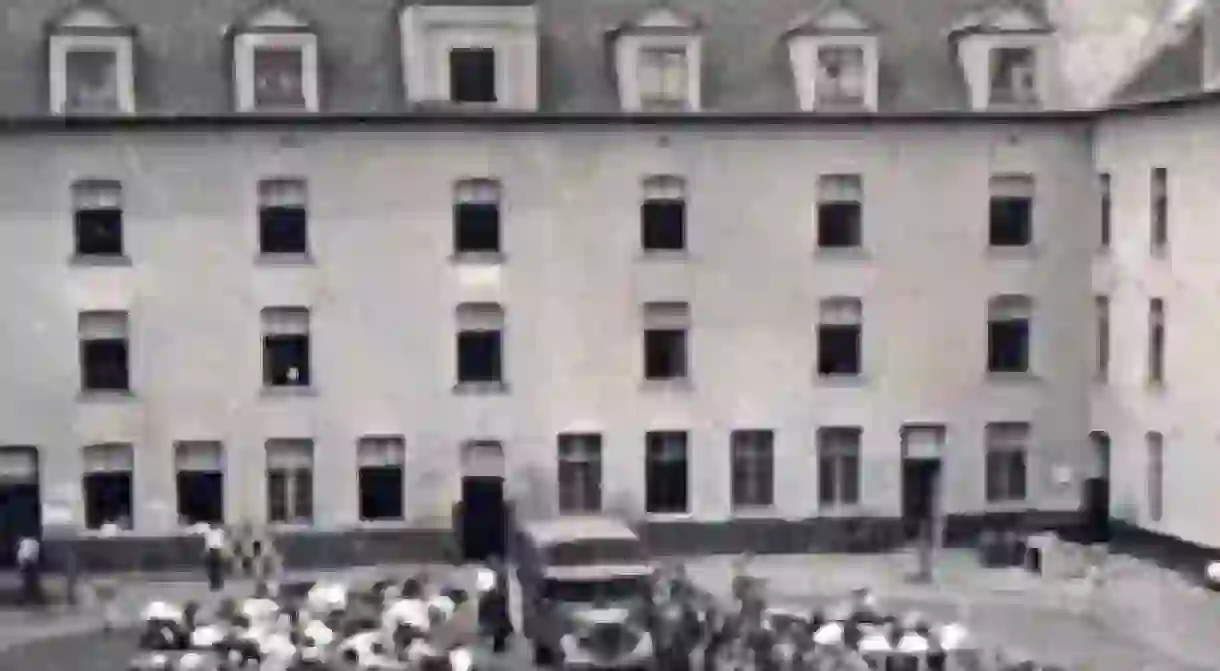Kazerne Dossin Holocaust Memorial And Museum In Mechelen

Mechelen, sitting on either side of the River Dijlestad, is a small Belgian city in the province of Antwerp, Flanders. In 1835, the first railway line in mainland Europe was constructed between Brussels and Mechelen, a journey that now takes twenty five minutes from Brussel Zuid. It is the railway that hides a dark secret.

As the city entered the Industrial Age, the Kazerne Dossin Memorial and Museum commemorates a very different kind of industry: slaughter. Over 100 years after the inauguration of the railway, the Nazi occupiers of Belgium used the line to deport 25,484 Jews and 352 Roma to the extermination camps of Poland, chiefly Auschwitz-Birkenau. 1,274 returned. That is one for every twenty (5%) of the faces that stare out over the four floors of the modern exhibition space. Alongside the Memorial, located in the 18th Century Austrian era barracks, in which the deportees were incarcerated, the primary focus of the Kazerne Dossin Museum is to give a face to the anonymous statistics that such figures become. The dehumanization of the victims is removed and the portrait becomes a person, not a number.

In spite of its complex and emotional subject matter, the Kazerne Dossin is a museum that deals directly with the lost legacy of the tens of thousands that were transported and killed. Kazerne Dossin has become, first and foremost, a memorial for the dead. It functions with a dual purpose, both educational and emotional. The Museum’s modern façade, designed by Bob Van Reeth represents a blank white block looking out over the barracks opposite. It is reminiscent of the white gravestones that so dominate the countryside of Northern France and Flanders’ fields. The Museum and Memorial are not two disparate entities but unite as a single cohesive site. They interact to form an architectural epitaph to the dead.

The nature of Kazerne Dossin, being on two separate sites, the white washed 1750s Monument and modern Museum, could be a major hindrance to the aims of the project. Especially when we consider the fact that the listed barracks have been occupied flats since 1980. The use of the Memorial in such a reduced space is affecting; distilling the identity of each individual through the audio exhibit, entitled Names and the visual, Faces. They manage to be both haunting – the names of the detained read aloud by schoolchildren in a Remembrance day style catalogue – and empowering, the footprints of those lost are restored to historical reality. These are the names and faces of those who were summoned to Dossin under the pretext of forced labor, then shepherded into 28 transports between July 1942 and September 1944, a thousand at a time. This was before Transport XX in April, 1943, in which the carriages were replaced with cattle trucks, allowing 1631 people. Largely through bravery, cunning and human will, 151 of the 1631 survived. Others were not so fortunate; transports III and IV took 2000 people. 5 survived. A Belgian railway company report filed on 27 April reads: “After the train had gone, bodies were found all along the tracks…To avoid unpleasantness with the occupying authority, the investigation was…kept to a minimum.” Most were shot dead by SS Troops in command of the train.

The report raises a significant theme of the Museum. The idea of collaboration under the occupation and to what extent the Belgians were in command of their own destiny in response to their rulers. The constitutional question is largely avoided, although King Leopold III remained in Belgium after the capitulation of his army. Once occupied, what evolves is a network of differing methods particular to each city. While Brussels seems a relative defender of the Jewish population after the refusal to introduce the Yellow Star, a symbol forced on every Jew in 1942, recently the city admitted its complicity in the registration of 5,640 Jews that hastened deportation (Brussels’ mayor apology). Antwerp, the staunchly Flemish nationalist province, led the rising wave of the anti-semitic invasion and whereas Brussels’ mayor, Jules Coelst refused to involve the city’s police in raids on the Jewish population, such raids occurred within Antwerp. Anti-semitism was not merely within the ruling classes: Tintin creator Hergé has been widely accused (see: Tintin in the Dock).
The introductory video charts the history of anti-semitism from the early Christian period through to the late 1920s. The introduction achieves a good overview of genocide, updating the Holocaust in the more modern context of Rwanda’s tribal massacres of 1994. Perhaps the Museum could go one step further and enlighten its visitors on current global conflicts. Though it is not in the scope of a museum to harbor political aims, a look at present day problems could serve as a dialogue with the past. An affective memorial could then perhaps become an effective mirror to the now.
Kazerne Dossin, Goswin de Stassartstraat 153, Mechelen, Belgium, +32 15 29 06 60













